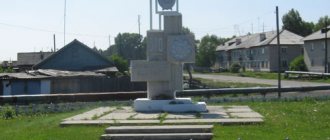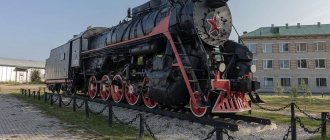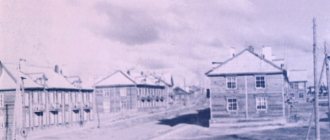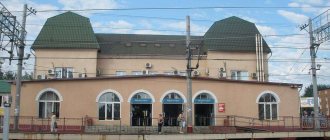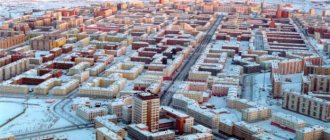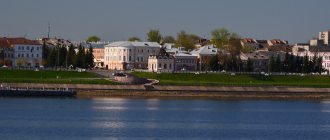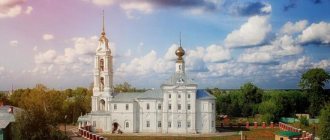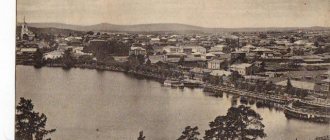Pages of history
The first mention of the village of Kulebaki is found in documents from 1678. In 1719, in the small village of Kulebaki, there lived 31 beekeepers and 27 “newly baptized” people, who had one inn. Since 1786, Kulebaki was a joint patrimonial and palace possession. In 1797, part of the lands belonging to the main palace chancellery was transferred to the appanage department, and the other part was granted “to the patrimonial ownership of the imperial family.” The first mention of the owners of Kulebak dates back to 1799 - these are Vasily Nikolaevich Samarin and his wife Maria Vasilievna, who ruled the village until 1807. In 1814, the village of Kulebaki, together with the “surrounding estates,” was in the possession of the collegiate adviser Alexandra Vasilievna Valueva. Since 1828, the village began to be governed by the state councilor Sofya Yuryevna Samarina. And in 1833, Kulebaki was bought by the collegiate assessor Nikolai Gavrilovich Fedorov. Fedorov himself did not live in Kulebaki. On his behalf, the village was ruled by N.A. Ganbeev, who oppressed the villagers in every possible way. It came to the point of peasant unrest. Residents of Kulebak were especially active in 1852 and 1859. Later, using the experience of neighboring Vyksa factories, N.G. Fedorov, together with the Vyksa merchant Borodachev, decided to build a metallurgical (mining) plant in Kulebaki using local ores. In the summer of 1866, a small blast furnace in Kulebaki began to smoke. In 1877, the first tire rolling shop in Russia began operating at the Kulebaki Ornament Plant, which produced tires for steam locomotives and carriages. With the development of the metallurgical plant, the village also developed. Together with the entire country, Kulaba residents restored their economy after the Civil War, defended their Motherland on the fronts of the Great Patriotic War, and worked hard in the post-war period. In 1932, the village of Kulebaki received city status.
Since 1930, the city newspaper “Kulebaksky Metallist” has been published, and the OJSC “Kulebaksky Metallurgical Plant” has published its own large-circulation newspaper. Since 1990, collections of poems by V. Ilyushkin, A. Elisov, Yu. Protsiv, M. Petunin, E. Klimova, N. Zharinova have been published.
Despite the difficulties, cultural and sports work is carried out in the city. The future of the city depends on the well-being of the main city-forming enterprises: OJSC KMZ, OJSC KZMK, a clothing factory, a bakery, a dairy.
V. Chernov, editor of the regional newspaper “Kulebaksky Metallist”
City today
During the years of Soviet power, entire microdistricts of residential buildings, several factories, a garment factory, a Palace of Culture, a Sports House, a cinema "Russia", a technical school building, a House of Communications, a House of Justice, the Metallurg Hotel, schools, kindergartens, a music and art school, city administration building and much more.
Recently, new buildings of Sberbank, the State Tax Inspectorate, a traffic police building, a branch of Promstroibank have been built, Victory Square has been reconstructed, Vorovskogo Street has been landscaped, the House of Mercy has been put into operation, and the second large market of Yarmarka LLC has been opened.
In 2008, the Temp sports and recreation complex was opened.
- Torovy
- Vorovskogo Street
- Gastello street
- Leisure Center
Photos of the city
Education and culture
- School № 1
- Lyceum No. 3
- School No. 6
- School No. 7
- School No. 8
- School No. 9
- School number 10
- Boarding school
- Children's art school
- Children and Youth Center
- Leisure center
- Center for Technical Creativity
- Metallurgical College
- Vocational school No. 74
- MGOU branch
- Palace of Culture
- Children's sports school
- Sports and recreation complex "Temp"
Content
- 1 Geography
- 2 History
- 3 Population
- 4 Administrative-territorial structure
- 5 Settlements
- 6 Municipal-territorial structure
- 7 Economy 7.1 Industry
- 7.2 Agriculture
- 7.3 Transport
- 11.1 Heroes of Labor
Honorary Kulaba residents
- HONORARY CITIZENS OF KULEBAKER DISTRICT
1 BEKLEMISHEVA Nina Vladimirovna
(1896-1987) For long-term work and special merits in the development of healthcare (doctor-ophthalmologist) Decision of the executive committee dated November 1, 1967 No. 255
2 PANTUROV Vasily Vasilievich
(1888 - 1973) “Honored Artist”, created and led brass, jazz, and pop music groups. Decision of the Executive Committee dated February 28, 1968 No. 44
3 EFIMOV Pavel Ivanovich
(1906-1983) Colonel General Since 1932 in the Soviet Army. WWII participant. He began his military service as a military commissar of a separate battalion and ended as the first deputy head of the Main Political Directorate of the Soviet Army and Navy. Awarded two Orders of Lenin, three Orders of the Red Banner, Order of the Red Star, 12 medals. Decision of the Executive Committee dated February 28, 1968 No. 43
4 BORISOV Ivan Timofeevich
(1903-1980) Major General Since 1932, he worked in the aviation industry of the USSR. From 1959 to 1972 worked in the State Planning Committee of the USSR, then head of a department of the Ministry of Aviation Industry of the USSR. For his great contribution to strengthening the defense capability of the USSR, he was awarded the Orders of Lenin, Kutuzov II degree, Red Star, two Orders of the Red Banner of Labor, medals. Decision of the Executive Committee dated February 28, 1968 No. 44
5 MAMONTOV Ivan Vasilievich
(1912-1988) Major General WWII participant. He worked in the Main Political Directorate of the Soviet Army and Navy. For his contribution to strengthening the defense capability of the USSR, he was awarded two Orders of the Red Banner, the Order of the Patriotic War, II degree, the Red Star and 12 medals. Decision of the Executive Committee dated 02/11/1970 No. 49
6 ORLOVA Valentina Dmitrievna
(1917-1999) “Honored Worker of Culture of the RSFSR”, “Excellent in Cultural Performance in the Village” from 1965 to 1984. - Director of the Kulebak Music School Resolution of the Zemsky Assembly dated July 17, 1998 No. 65
7 RABINOVICH Anatoly Yakovlevich
(1912-2005) He began his career as a foreman in the mechanical repair shop of KMZ. From 1961 to 1983 - Director of the Kulebaki Metallurgical Plant Recipient of 2 Orders of Lenin, the Order of the October Revolution, awarded the medals “For Valiant Labor in the Second World War 1941-1945”, “For Labor Distinction”, etc., awarded the title “Honorary Aircraft Builder” Resolution of the Zemsky Assembly dated July 17, 1998 No. 65
8 KHLOPKOV Alexander Mikhailovich
(07/28/1926). He began his career as a foreman in the mechanical repair shop of KMZ. From 1961 to 1983 - Director of the Kulebaki Metallurgical Plant Recipient of 2 Orders of Lenin, the Order of the October Revolution, awarded the medals “For Valiant Labor in the Second World War 1941-1945”, “For Labor Distinction”, etc., awarded the title “Honorary Aircraft Builder” Resolution of the Zemsky Assembly dated July 17, 1998 No. 65
9 GREBNEV Vladimir Nikolaevich
Honored Doctor of the RSFSR, total experience in the healthcare sector for 45 years. In 1957, he headed the network of medical institutions in the city. from 1968 to 1992 – chief physician of the Central Regional Hospital. He did a lot to strengthen the material and technical base of medical institutions, to improve the quality of medical services for the population of the region. Awarded the Order of “Badge of Honor”, the badge “Excellence in Health Care of the USSR” Resolution of the Zemstvo Assembly dated July 11, 2000 No. 41
10 MOSHKOV Yuri Georgievich
He worked his way up from a marking master to the general director of the Kulebaki Metal Structures Plant. He stood at the helm of KZMK for a quarter of a century. Since 1988, he worked at the radio unit plant, in the reception room of the People's Deputy of the USSR, and in the Zemsky District Assembly. And only in 1997 he retired. Awarded two Orders of the Red Banner of Labor, the “Badge of Honor” and seven medals Resolution of the Zemstvo Assembly dated June 27, 2003 No. 61
11 DOGADINA Lidiya Nikolaevna
Born 1926 Since 1949, she worked at the Kulebak Central District Hospital as an obstetrician-gynecologist. From 1958 until her retirement, she headed the maternity ward of the Central District Hospital, and was the chief specialist in the field of obstetrics and gynecology. During her well-deserved retirement, she worked for 7 years in the first-aid post of a garment factory. Only at the age of 72 in 19998 did she stop working. She was an assessor in the people's court for 32 years. By decision of the Zemsky Assembly dated September 11, 2007 No. 65
- HONORARY VETERANS OF KULEBAKER DISTRICT
1 POPOV Ivan Petrovich
Born 1924 Participant of the Great Patriotic War. He was demobilized in 1947 and began working as a military instructor at a metallurgical plant. Then he worked in the public education system - he taught military affairs, physical education and physics at schools No. 6 and evening school. An active participant in the public life of the region, he stood at the origins of the veteran movement. For many years he was the chairman of the war veterans committee at the Veterans Council. He has state awards: Order of the Patriotic War, 1st degree, medals “For the Defense of Leningrad”, “For Victory over Germany”, others. Resolution of the Zemsky Assembly dated April 22, 2005 No. 34
2 ILICHEV Konstantin Egorovich
(1917-2006) From 1935 until his retirement, he worked at the Kulebaki Metallurgical Plant. WWII participant. For many years he was a freelance inspector of the Kulebaki Department of Internal Affairs, a freelance correspondent for the newspapers “Gorkovskaya Pravda”, “Trud”, “Kulebaki Metallist”, “Kirovets”. Awarded the Order of the Patriotic War, 1st degree, medals “For Courage”, “For the Liberation of Warsaw”, “For the Capture of Berlin”. Resolution Resolution of the Zemsky Assembly dated June 29, 2005 No. 62
3 CHERNYSHOVA Nina Fedorovna
Born 08/15/1929 From January 1950 until her retirement in 1986, she worked at the Kulebaki Metallurgical Plant, where she worked her way up from a technologist to the head of the metallurgical group of the laboratory of steels and alloys. She continued to work after retirement as the head of the Matrosov training center, the head of the reconstruction of the Park of Culture, and for 12 years as the director of the Museum of Metallurgists. For 21 years he has been the permanent Chairman of the Council of Veterans of the NGO Union of Pensioners of the Russian Federation of OJSC Ruspolymet. She was awarded many honorary titles, certificates and badges. By decision of the Zemsky Assembly dated September 11, 2007 No. 66
Religion[ | ]
The population of the area is mainly of the Orthodox Christian faith. There are 11 Orthodox churches in the area, as well as 2 monastery hermitages and 1 temple under construction. There is a Protestant local church of Evangelical Christian Baptists (ECB) in the area. In addition, representatives of the Roman Catholic Church live in the area, as well as Lutherans and representatives of other Christian denominations, including Old Believers of various accords, with a temple. Muslims also do not have a mosque. Islam is practiced mainly by visiting representatives of the Caucasian republics and Central Asia.
Story
In 1655, the Mordvin Chenbas handed over the flatbed near the Kulebaki River to Andryushka Silin.
This is how the industrial center of the Nizhny Novgorod region, the city of Kulebaki, began.
The origin of the name of the settlement Kulebaki can be assumed to be from the Mordovian words “kuley” (beehive) and “baki” (vessels) and is associated with the beekeeping of the first Mordovian settlers, who collected honey from the hives of wild bees. To the east of the city there is an area that the population has long called Ulishch. Some old-timers associate the origin of the name of the village with the industries of charcoal burning and tar smoking, with the production of coolers and tanks (coal was put into coolers, and tar was poured into tanks).
The village of Kulebaki was first mentioned in 1678, and in 1719, 31 beekeepers and 27 “newly baptized” people lived in the village, who had a small inn (Kulebaki stood on the busy Siberian Highway). “Bread was born the worst” throughout the area, so the amount of cultivated land increased slowly. So, in 1745, near the village of Kulebaki there were 7.5 dessiatines of arable land and 6.1 dessiatines of hayfields. The typical occupation of the residents was logging and rafting of timber.
Since 1786, Kulebaki was a joint patrimonial and palace possession. In 1797, part of the lands belonging to the main palace chancellery was transferred to the appanage department, and the other part was granted “to the patrimonial ownership of the imperial family.”
The first mention of the owners of Kulebak dates back to 1799 - they are Vasily Nikolaevich Samarin and his wife Maria Vasilievna, who ruled the village until 1807.
In 1814, the village of Kulebaki was, together with the “neighboring landowners,” in the possession of the collegiate adviser Alexandra Vasilievna Valueva. She financed the construction of the Church of the Resurrection, which adorned the village for more than a century. The expenses incurred by Valueva for the construction of the stone church led to the fact that in 1828 the estate was sold to state councilor Sofya Yuryevna Samarina.
In 1833, Kulebaki was bought by the collegiate assessor Nikolai Gavrilovich Fedorov. When taking possession, he found the peasants “in an unenviable position”; they “had the name of robbers and thieves on them, so those passing through prayed for safe passage to the village of Kulebaki.” N. G. Fedorov constantly lived in Moscow and did not go to the village at all “for fear of being exposed to great trouble and misfortune” on the part of the peasants.
In 1866, Fedorov, together with the Vyksa merchant Borodachev, founded a mining plant in Kulebaki, and a blast furnace was built. In 1877, the first open-hearth furnace was built - one of the few in Russia. By 1900, in terms of production volume (bandages, sheet and rolled products, rails, steel and cast iron castings, etc.), the plant was second only to the Sormovo plant.
After the construction of the Mining Plant in Kulebaki, the number of residents increased rapidly. To accommodate the factory population, which reached 7–8 thousand, 80 houses were built in the village.
In 1897, a wooden church was built in the village in the name of St. Nicholas the Wonderworker, in memory of the consecrated coronation of “their imperial majesties, through the diligence of the employees, craftsmen and workers of the Kulebaki Mining Plant of the Kolomna Machine-Building Plant Society.” The church took 20 months to build. The structure was erected on the outskirts of the village, on level ground. Above the entrance to the church there was a three-tiered bell tower (in plan - a square with a side of 7.1 m, a height of 20.2 m, the size is given to a tetrahedral pyramidal tent covering with a dome and a cross). The vestibule was illuminated by large windows (1.7 m wide) with colored glass and stained glass. The height of the vestibule is 6 m. The middle part of the church was covered by a dome in the form of a four-pointed star, ending with a drum 4.97 m high with a hipped tetrahedral pyramidal covering with a dome and a cross. The temple was designed for a thousand people.
The bell tower housed 9 bells with a total weight of 575 pounds. The weight of the main bell is 321 poods 15 pounds.
The yard and barn are covered with straw, “where tows”, dried brooms and other supplies are hung over the huts. Withered and smoke-blackened huts, black baths, and merchants' shops were all that could be seen in Kulebaki at the beginning of the 19th century.
At the beginning of the twentieth century. in Kulebaki there were 360 houses. The main street, which now bears the name of Stepan Razin, and dozens of so-called soldiers' settlements. There was a church in the center. In addition to rural buildings, the plant built barracks for plant workers and houses on Zelenaya Street for management employees.
By 1927, the boundaries of the workers' settlement had moved quite noticeably. The village was entirely wooden, apart from five stone houses of wealthy owners.
In the mid-20s, a GORES electrical substation was built, but back in 1927, many houses were lit with kerosene lamps.
Sometimes new things were introduced into everyday life with great effort. In the fall of 1931, for example, they opened the first kindergarten, then the second and third, and went around the workshops, agitating parents to send their children to be raised.
Since Kulebaki was awarded city status in 1932, construction has been actively underway. The area of the city has increased five to six times in 15 years. Most of the population moves into multi-storey stone houses. In the 40s a metal structures plant, a timber industry enterprise and others appeared. By 1982 The area of the city increased 50 times.
Municipal-territorial structure[ | ]
Until 2015, there were three urban and four rural settlements in the Kulebak municipal district:
| № | Urban and rural settlements | Administrative center | Number of settlements | Population | Area, km2 |
| 1 | urban settlement Kulebaki city | Kulebaki city | 2 | ↘33 759[15] | 80,92[3] |
| 2 | urban settlement working village Veletma | working village of Veletma | 1 | ↘1024[15] | 127,80[3] |
| 3 | urban settlement working village Gremyachevo | working village of Gremyachevo | 1 | ↘5174[15] | 20,29[3] |
| 4 | Murzitsky village council | village of Murzitsy | 3 | ↘2287[15] | 98,34[3] |
| 5 | Savasleysky village council | Savasleika village | 4 | ↘2561[15] | 160,51[3] |
| 6 | Serebryansky village council | Serebryanka village | 12 | ↘479[15] | 265,39[3] |
| 7 | Teplovsky village council | village Teplovo | 4 | ↘4485[15] | 169,14[3] |
In 2015, all municipalities of the district were transformed by merging them into the newly formed municipality of the urban district of the city of Kulebaki[9].
Attractions
Teremok Museum
The main attraction of the city of Kulebaki, Nizhny Novgorod region, is rightfully considered the building of the Kulebaki Metallurgical Plant Museum; once within these walls there was a people’s house. The building is made of wood, and is an example and monument of provincial wooden architecture of the early twentieth century. Today the building houses a museum in which experienced guides talk about the history and development of the city-forming metallurgical plant, as well as the history of the city and the military and labor exploits of the local population. This attraction is located on Vostochnaya Street in Kulebak.
File:338898b5-6ea5-46a6-91f2-438bdcbb042e.jpeg
Sources:
In the area of the city there is also an Orthodox landmark, the center of Christian life in the region, the Kutuzovsky monastery of the Seraphim-Diveevo convent, founded in 1864.
Once upon a time there were many ancient churches and temples in Kulebaki, but during the Bolshevik persecution of the churches they were all dismantled, destroyed or blown up.
Population[ | ]
| Population | ||||||||
| 2002[10] | 2008[11] | 2009[11] | 2010[10] | 2011[11] | 2012[12] | 2013[13] | 2014[14] | 2015[15] |
| 57 000 | ↘53 710 | ↘53 251 | ↘52 377 | ↘52 186 | ↘51 457 | ↘50 775 | ↘50 305 | ↘49 769 |
| 2016[16] | 2017[17] | 2018[18] | 2019[19] | 2020[4] | ||||
| ↘49 269 | ↘48 730 | ↘48 173 | ↘47 619 | ↘47 165 | ||||
Urbanization
80.08% of the district's population live in urban areas (the city of Kulebaki, the working villages of Veletma and Gremyachevo).
Age composition
58,780 people live in the Kulebaksky district, including:
- younger than able-bodied – 11,600 people
- able-bodied – 35180 people
- older than able-bodied – 12,000 people.
National composition of the population
The main population is Russians.
Economy
The leading industries of Kulebak are metallurgy, metalworking and mechanical engineering. The city is the center of a developed forestry and woodworking industry.
The city-forming enterprise is a metallurgical plant (Vosstaniya St., 1). Start LLC (a subsidiary of Ruspolimet OJSC) (Vosstaniya St., 1). Metal structures plant OJSC Kulebaksky ZMK Soyuzlegkonstruktsiya (Nekrasova St., 12). OJSC "Kulebaksky Dairy Plant" (Voykova St., 1). CJSC "Kulebak Sewing Factory" (Ulyanova St.). OJSC "Kulebaksky Bakery" (Voikova St., 1a). MPK LLC - meat processing plant (Murzitsy village). Enterprise "Stankoless" (Serova St., Industrial site No. 2). LLC "KulebakiDorStroy" (Zheleznodorozhnaya St.). LLC "Spetsstroymontazh" - reinforced concrete plant (Voykova St., 3/5). The volume of shipped goods of own production, work and services performed in-house in manufacturing industries in 2010 amounted to 6.54 billion rubles.
Settlements[ | ]
The city of regional significance and urban district includes 27 settlements:[20]
| List of settlements in the district | ||||
| № | Locality | Type | Population | administrative-territorial entity |
| 1 | Blagoveshchenka | village | ↘12[10] | Serebryansky village council |
| 2 | Veletma | village | ↗957[4] | Veletma village council |
| 3 | humpback | village | ↗4[10] | Savasleysky village council |
| 4 | Gremyachevo | workers' village | ↘5017[4] | working village of Gremyachevo |
| 5 | Znamenka | village | ↘0[10] | Serebryansky village council |
| 6 | Krasnovka | village | ↘6[10] | Serebryansky village council |
| 7 | Red Spring | village | ↘16[10] | Serebryansky village council |
| 8 | Kulebaki | city, administrative center | ↘31 794[4] | Kulebaki city |
| 9 | Kutuzovka | village | ↗30[10] | Serebryansky village council |
| 10 | Sawmill | village | ↘3[10] | Serebryansky village council |
| 11 | Lomovka | village | ↘1536[10] | Teplovsky village council |
| 12 | Melyaevo | village | ↗198[10] | Teplovsky village council |
| 13 | Mikhailovka | village | ↘158[10] | Serebryansky village council |
| 14 | Dairy farm | village | ↗271[10] | Murzitsky village council |
| 15 | Murzitsy | village | ↘1801[10] | Murzitsky village council |
| 16 | We are for it | village | ↗37[10] | Savasleysky village council |
| 17 | New Savasleika | village | →10[10] | Savasleysky village council |
| 18 | Pervomaisky | village | ↘311[10] | Murzitsky village council |
| 19 | Pushley | village | ↘12[10] | Serebryansky village council |
| 20 | Savasleika | village | ↘2686[10] | Savasleysky village council |
| 21 | Serebryanka | village | ↘285[10] | Serebryansky village council |
| 22 | State Farm | village | ↘0[10] | Serebryansky village council |
| 23 | Teplovo | village | ↘1738[10] | Teplovsky village council |
| 24 | Tumaleika | village | ↘6[10] | Serebryansky village council |
| 25 | Ulishche | village | ↘74[14] | Kulebaki city |
| 26 | Shiloksha | village | ↘1136[10] | Teplovsky village council |
| 27 | Shilokshley | village | ↘0[10] | Serebryansky village council |
From January 1, 2022, the working village of Veletma was transformed into a rural settlement with the formation of the administrative unit Veletma Village Council[21].
Data
The great Russian poet A.S. Pushkin passed through Kulebaki several times, as evidenced by his letters to his wife. In the 19th century, at the Veletminsky ironworks near Kulebak (the plant was closed in 1895), especially high-quality Lithuanian steel was invented and produced, which previously could only be cast by the British, who kept their secret very strictly. In 1878, the first shallow-draft river steamer “Kulebaki” was built at the Kolomna Machine-Building Plant. In the summer of 1901, Kulebaki was visited by the chamberlain of the imperial court, Minister of Internal Affairs Dmitry Sergeevich Sipyagin, who was touring the Nizhny Novgorod province. Getting acquainted with the life of the factory and village, he visited the People's House. In 1936, the two millionth bandage was produced at the Kulebaki Mining Plant, and the millionth bandage was laid at the base of the pedestal of the bust of Lenin - one of the first metal monuments to Lenin (located in front of the local history museum in 1925)
The millionth KMZ bandage, photo from 1936. The Kozma Minin and Ilya Muromets armored trains, which went to the front in March 1942 as part of the 31st special Gorky division of armored trains, were made of steel produced at the Kulebaki Metallurgical Plant. In 1946, Kulaba residents A.I. Fomichev and N.A. Frumkin produced solid anchor chains, for which they were awarded the Stalin Prize. In the post-war years, at the Kulebak metal structures plant, a welding electrode of the SK brand was manufactured and received all-Union recognition, which was superior in quality to others produced in the USSR. Kulebaki is the birthplace of bandage rolling production in Russia.
| Cities of the Nizhny Novgorod region |
| Arzamas | Balakhna | Bogorodsk | Bor | Vetluga | Volodarsk | Vorsma | Vyksa | Gorbatov | Gorodets | Dzerzhinsk | Zavolzhye | Knyaginino | Kstovo | Kulebaki | Lukoyanov | Lyskovo | Navashino | Nizhny Novgorod | Pavlovo | Pervomaisk | Transportation | Sarov | Semenov | Sergach | Uren | Chkalovsk | Shakhunya |
